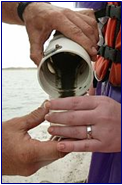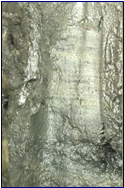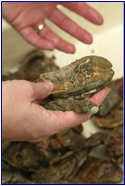|
The type of sediment located at each of the sites can give information about the biological and geological processes around them. At site three, which is at Nickaqompas Creek, the sediments found on the bottom were a silty clay [5y(3/1) or 5Y(3/2)]. The sluggish material was dark gray with a hint of green. This silty clay that has a dark gray color indicates a soil that is rich in organic material. Estuaries are know as the nursery homes of the oceans. This soil supports that site three is at the heart of an oceanic nursery. Site three had calm waters that would not disturb young animals. Of all of the locations that we took sediments from, site three had the most amount of large biological life. Just to name some, we saw crabs, fish, snails, lots of birds, and squid. These large animals feed on smaller animals, who in turn feed on smaller animals, and so on. Having a large population of large animals indicates a large amount of smaller animals. This is the location where many of the young creatures spend their early days.
At site two we did not find any grain size samples. We only found shells. This would indicate that at site two a lot of the smaller material is being washed away in some direction. Because the tides continuously rushing into and out of estuaries sediments are constantly being washed into an estuary when the tides come in, and out of the estuary when the tides go out. The sediments are deposited outside of the mouth of the estuary, creating a fan shaped mound of freshly deposited sand. Because there are only shells and no sand at site two, I would think that the sediments from this area has been excavated due to tidal changes and deposited elsewhere.
However, site one is made up of a sand material [2.5y(4/4)] that is an olive brown color. This sandy material seemed to be a mixture of the silty material found at site three and the lighter colored sand grains that we find on the beaches. Sand is a course gained material that is created by breaking down rocks and shells into small angular pieces. The sediment at site one is a mixture of the sediment found at site three and sandy material that could either be broken down shells from site two and or rocks that have been broken down as they travel from upriver. This mixture would be found in the fans that form where sediments are dumped from the ebbing and flooding tides. |
|
Sediment from site one |
|
Shells from site two |
|
Sediment from site three |


